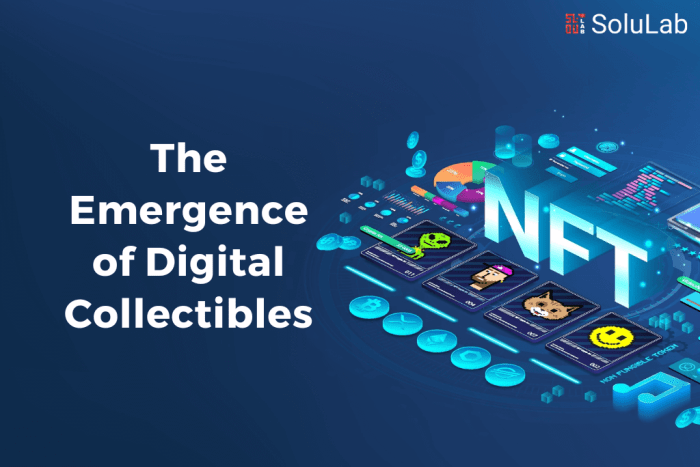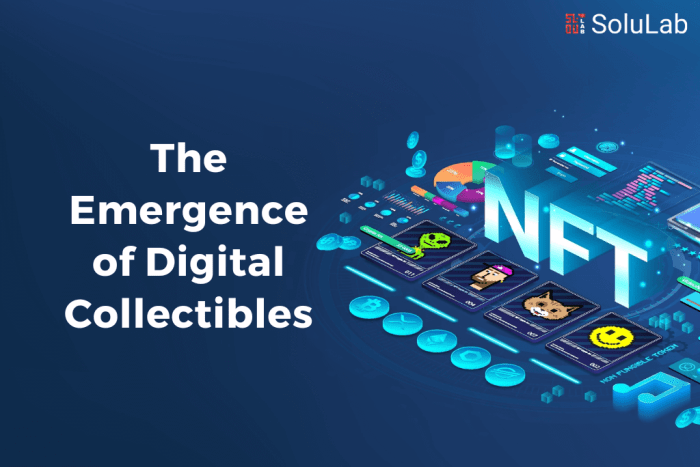Digital Collectibles are exploding! Forget baseball cards – now it’s all about owning unique digital assets, from NFTs representing artwork to virtual real estate in the metaverse. This isn’t just some passing fad; it’s a whole new landscape shaping how we think about ownership, art, and even community. We’ll explore the tech behind it all, the wild market fluctuations, and the legal grey areas that are constantly evolving.
This deep dive will cover everything from the core characteristics of digital collectibles, including the different types like NFTs and in-game items, to the underlying blockchain technology that makes them work. We’ll also examine the bustling marketplaces where these items are bought and sold, the legal and regulatory challenges, and finally, a peek into the future of this rapidly expanding digital frontier.
Community and Culture

Digital collectibles aren’t just JPEGs; they’re catalysts for vibrant online communities and evolving digital cultures. These communities, often built around specific projects or shared interests, provide a space for creators and collectors to connect, collaborate, and shape the future of this rapidly expanding market. The interplay between these two groups is crucial to the ecosystem’s overall health and innovation.The role of creators and collectors in shaping the digital collectibles ecosystem is a dynamic two-way street.
Creators, through their artistic vision and technical skill, establish the foundation of the market, generating unique and desirable assets. Collectors, through their purchasing decisions and community engagement, influence which projects thrive and which ones fade into obscurity. This symbiotic relationship fuels innovation and pushes the boundaries of digital art and technology.
Community Building and Interaction
Online communities surrounding digital collectibles often function as forums for discussion, feedback, and collaboration. Many projects feature dedicated Discord servers or other social media groups where holders can interact with developers, share their collections, and participate in community-driven initiatives. This constant engagement fosters a sense of belonging and shared passion, enriching the ownership experience beyond the mere possession of a digital asset.
For example, the Bored Ape Yacht Club community is renowned for its strong sense of community, with members collaborating on projects, organizing events, and supporting each other’s endeavors. This active participation significantly increases the value and appeal of the NFTs themselves.
Creator and Collector Influence, Digital Collectibles
Creators and collectors exert considerable influence on the direction of the digital collectibles ecosystem. Creators, by releasing new collections and engaging with their community, shape trends and set aesthetic standards. Collectors, through their purchasing patterns and market participation, dictate the demand for specific types of digital art and influence pricing. This constant feedback loop ensures that the market adapts to evolving tastes and technological advancements.
The success of projects like CryptoPunks demonstrates the impact of early collectors, whose initial support helped establish the project’s prominence and long-term value.
Creativity and Collaboration
Digital collectibles frequently foster creativity and collaboration among artists and collectors. Many projects encourage community participation in the design process, allowing collectors to influence the direction of the project. Furthermore, some platforms facilitate collaborative art projects, where multiple artists contribute to a single NFT, blurring the lines between individual creation and collective effort. This collaborative approach expands the creative possibilities and leads to innovative artistic expressions.
For example, some projects use community-driven voting mechanisms to determine the direction of future releases, directly involving collectors in the creative process.
Cultural Significance and Artistic Expression
Digital collectibles are gaining increasing cultural significance as they challenge traditional notions of art ownership and artistic expression. They represent a new form of artistic creation and distribution, bypassing traditional gatekeepers and opening up new avenues for artists to connect with their audience. The accessibility and global reach of digital marketplaces have democratized art appreciation and broadened the definition of art itself, impacting how we perceive and interact with creative works.
The integration of digital collectibles into the metaverse and other virtual worlds further amplifies their cultural influence, shaping the aesthetic landscape of these digital spaces.
Illustrative Examples

Digital collectibles, or NFTs, encompass a vast and diverse landscape. Understanding their varied forms and value propositions is crucial to grasping the broader impact of this technology. The following examples showcase the spectrum of possibilities, from generative art to utility-driven tokens and community-focused projects.
CryptoPunks
CryptoPunks are 10,000 uniquely generated pixel art images of punks, each with its own distinct attributes like hairstyle, accessories, and facial features. These were created in 2017 by Larva Labs, and their initial low cost and scarcity drove early adoption and hype.
- Creation Process: Generated algorithmically, ensuring each Punk is unique and unrepeatable. The code was publicly available, fostering transparency and trust within the community.
- Artist: Larva Labs, a pseudonymous collective, created the generative algorithm and released the collection.
- Community Engagement: CryptoPunks fostered a strong community based on early adoption, rarity, and the unique visual aesthetic. Owners actively trade, showcase, and discuss their Punks, creating a vibrant online culture. The high value of certain Punks has also led to real-world exhibitions and collaborations.
Bored Ape Yacht Club (BAYC)
Bored Ape Yacht Club NFTs are another hugely successful example, featuring 10,000 unique cartoonish ape images, each with different attributes. The project leveraged both art and utility to create significant value and community engagement.
- Creation Process: Similar to CryptoPunks, BAYC utilized a generative algorithm to create unique ape images. However, BAYC’s art style was more polished and immediately recognizable.
- Artist: Yuga Labs, a company that has built an extensive ecosystem around the BAYC NFTs.
- Community Engagement: BAYC’s success stems largely from its strong community. The project offered exclusive access to events, merchandise, and other benefits for holders, fostering a sense of belonging and shared ownership. The community’s creativity has also led to spin-off projects and collaborations, extending the project’s influence beyond the initial NFT collection.
World of Women (WoW)
World of Women stands out as a collection explicitly focused on diversity and inclusion. It features 10,000 unique portraits of women, showcasing various ethnicities, hairstyles, and attire. This commitment to representation differentiates it from many other NFT projects.
- Creation Process: The artwork was meticulously crafted by Yam Karkai, focusing on detailed and expressive portraits. While not algorithmically generated, each piece maintains its uniqueness.
- Artist: Yam Karkai, a digital artist with a strong focus on representation and inclusivity in her work.
- Community Engagement: WoW actively promotes its community and values through various initiatives. The project’s focus on diversity resonates with a broad audience, building a supportive and inclusive community. This community actively participates in charitable initiatives, further strengthening its bond and positive impact.
FAQ Compilation: Digital Collectibles
What are the risks of investing in digital collectibles?
Like any investment, digital collectibles carry risk. Market volatility is a major factor; prices can fluctuate wildly. Scams and fraudulent projects are also a concern, so thorough research is crucial before investing.
How do I store my digital collectibles securely?
Secure storage is key. Use reputable digital wallets that offer strong security features like two-factor authentication. Never share your private keys with anyone.
Are digital collectibles taxable?
Tax laws surrounding digital collectibles vary by jurisdiction. Generally, gains from selling digital collectibles are considered taxable income, so it’s important to understand the tax implications in your area.
How can I tell if a digital collectible is authentic?
Authenticity verification depends on the platform and the type of collectible. Look for verifiable provenance on the blockchain, reputable marketplaces, and check for community verification on the project’s official channels.
